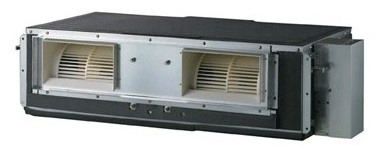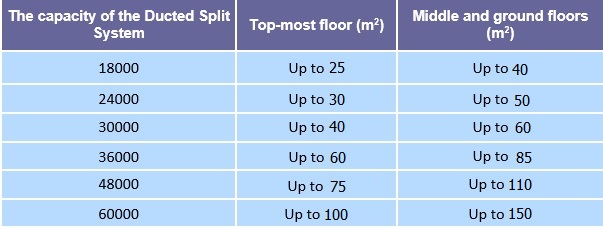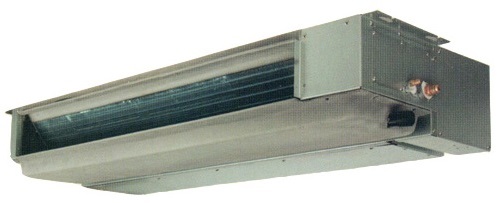- Cooling and Ventilation Equipment
- 0 likes
- 1919 views
- 0 comments
Ducted Split System important tips
Want to use ducted split air conditioners to ventilate your apartment house or office but you are not sure of the type, capacity, brand, price, and specifications that suit your purpose? Read on to find the answers to all your questions on price, technical specifications, and the best-ducted split air conditioners on the market.
Ducted split systems are among the most common cooling and heating systems in apartments.
The system provides thermal comfort—as adjusted by the thermostat—throughout an entire building by supplying cool air in the summer and warm air in the winter through ducts installed in the drop ceiling.
The ducted split system comprises two components namely, the indoor unit (air handling unit) and the outdoor unit (condenser) that are connected by two copper tubes and are capable of supplying cool air and distributing it among rooms in an apartment through ducts installed in the drop ceiling.
Click to view brands, models, and different types, find out the price, and Buy A ducted split.

Generally speaking, the ducted split system operates by cooling down the refrigerant in the condenser and transferring it, through copper tubes, to the expansion valve where it is directed toward the coil in the indoor unit for collecting heat from the space. The refrigerant, running through the coils of the indoor unit, collects heat from the air coming from the indoor space, and the cooled air is blown into ducts by a fan.
Ducted Split Systems Can be Categorized into Two Groups
- Normal ducted split systems (Grade B)
- Inverter low-consumption ducted split systems (Grade A), that have been designed and produced with Grade A energy efficiency to prevent high electric bills. In inverted ducted split systems, the speed of the compressor is variable as it can be reduced in response to a reduction in the room temperature.
Basically, When and Where Are Ducted Split Systems Used?
According to load calculations, using ducted split systems for cooling and heating in residential buildings, office buildings, and villas is considered a luxury option with identical power consumption costs—if not higher—than mini-splits. Ducted split systems are often used to replace several mini-splits in one apartment. In addition to providing independence in cooling and heating for each apartment, using these systems will reduce the costs of maintenance and operation of an air conditioning system. Our consultants at DamaTajhiz are ready to offer you the best-ducted split system options from the top manufacturers according to the technical conditions and the economy of your project.
Estimating the Required Capacity for a Ducted Split System and other Considerations
- Often, to make an initial estimate of the required refrigeration capacity of a ducted split system for an apartment in a climate similar to Tehran, approximately 1 ton of refrigeration is assumed for every 35–40 square meters of the total building area (nearly 400 BTU/hr per effective sq. meter) in the middle floors of a building—that is not exposed to direct sunlight in the summer, or the cold in the winter. Therefore, for apartments over 120 sq. meters, it is best to use two ducted split systems. Further, note that 12,000 BUT/hr is equal to 1 ton of refrigeration.
- In apartments of up to 150 sq. meters, single-phase ducted split systems running on 32 amp power (some brands) can be used without the need for filing a request for three-phase power with the local authorities.
- Even for apartments up to 200 sq. meters, you can use a ducted split system running on a single-phase, but 50 amp, power.
- To the best of our knowledge, building constructors are required by Tavanir—the local administrator of electrical power production, transmission, and distribution in the Tehran area—to three-phase power for their apartments if they are over 200 sq. meters.
- Another thing to note when selecting a ducted split system is to consider their aeration capacity, which is typically around 400 CFM per ton of capacity of the ducted split system. Obviously, a lower aeration capacity means less noise while with higher capacity the ducted split system makes more noise in operation.
- Before deciding on any of the following ducted split systems, one must note whether it operates on single-phase or three-phase power and compare its ampere (A) rating with the building’s electric meter.
- For the sake of the facility, you can consult the following table for approximating the required capacity for the ducted split system based on the conditions and the discussed principles.
Notice: The following capacity estimations are approximate and assume residential building use in a climate similar to that of Tehran, with a floor-to-ceiling distance of 2.8 m, no crowding or increase in the latent heat, no high-consumption electrical equipment, and no structural glass or curtain walls, especially on the west side of the building.
Advantages of the Ducted Split System
- Long service life
- The facility of start-up and operation
- Serving for both cooling and heating
- Allowing for using fresh air, if needed
- Can be used in large spaces with various uses
- Can also serve for heating, with the help of a heating coil
- Dehumidification and filtration of the air and removing the pollutants and pathogens
- Disposing of the chiller system, cooling tower, central boiler room, radiators, and the required piping
- Allows for placing an air filter and adjusting the temperature at each point in the space-separated by a thermostat and thermostatic control valves
Other features of the ducted split systems include
a. Easy and low-cost maintenance
b. Can be installed horizontally to take minimum space
c. Does not require scattered piping across the floor and on the ceiling
d. Does not require vertical duct placement and reduces the shared space in apartments
e. Uniform Transfer of cooled or heated air through the ducts implemented inside the drop ceiling
f. Independence for each apartment, which results in reduced maintenance costs and does not require employing a maintenance technician

General Ducted Split System Selection Tips
- The correct choice of capacity, manufacturer, and location of the ducted split system
- Deciding on whether to go with an inverter ducted split system (basically, inverter models reduce power consumption and prevent electrical shocks by manipulating the compressor speed)
- The correct implementation of the ducts and the copper tubes to ensure the highest efficiency
- To determine the required capacity, make sure to first turn in the latest plan of the building and the floors to our specialists at the DamaTajhiz consultation center for heating and cooling equipment by fax or email
- Before making your choice and placing an order for a ducted split system, be sure to take into account whether the system runs on single- or three-phase power, as well as the required amp (A) rating—according to the specifications of the apartment’s electric meter—in addition to the dimensions of the air handling unit
- Given the significance of balancing the aeration fan, as regards the performance of the ducted split system and its direct impact on the service life of the ball bearing motor, make sure to have the system installed perfectly horizontally and balanced to maintain the dynamic balance of the fan
- When implementing the ducts in a ducted split system, the return air vents must be installed at the farthest possible distance to the supply air vents
- Knowing the indoor temperature is of great importance to the thermostat for controlling the operation of the aeration fan, the location of the thermostat is critical with the systems that do not integrate a thermostat in at the return air inlet. Therefore, when locating the thermostat—making sure to install it at 140 cm from the floor—never place it exposed to direct sunlight or the supply air or near hot water supply lines
- When implementing copper tubes at a height, place an oil trap in 6 m intervals
- In general, the cost of implementing supply and return air ducts and copper tubes between the indoor ducts and the outdoor unit in apartments can vary depending on the distance between the two components, but as a rule of thumb, the costs can be estimated at 20–30% of the price of the ducted split system—approximately
Comparing the Ducted Split System with Mini-Chillers
- It is always interesting to contractors how do the costs of procurement and implementation of a ducted split system compare with those of a mini-chiller (plus fan coil units). According to our consultants at DamaTajhiz, estimating and comparing the costs depends on several factors, including the selected models, the floor area, the location of the equipment, and its installation.
However, under typical conditions, the final cost of procurement and implementation of the ducted split system is estimated to be roughly 40% less than that of a mini-chiller (plus ceiling fan coils) for a residential apartment. - As regards operating costs—which covers costs of power consumption, periodic maintenance, and recharging the refrigerant—there is no significant difference between the two systems, but in ducted split systems with over 3 tons of refrigeration installed without an intake vent or proper duct design, the passage of air can be awfully noisy.
Methods of Heating in Ducted Split Systems
- Heating Coil: In buildings equipped with a ducted split system, the most common method of heating—accounting for over 90% of the cases—is to use a heating coil sized proportionally to the outlet of the split system. An inverter ducted split system, that is capable of providing both heating and cooling with the help of the compressor, using a heating coil is recommended for the purpose of heating, for it offers a considerable reduction in power costs.
- In the winter, hot water is supplied by the central heating system of the building (boiler) or the packaged heating system of the apartment and delivered to the heating coil of the ducted split system that can now supply heated air to the rooms.
- Heat Pump: Another method of supplying heated air using ducted split systems is to use heat pumps. In addition to their high power consumption and insufficient heating for many climates, the condenser of the heat pump systems can suffer from frost in sub-zero temperatures.
- Electric Coil: Using electric heating coils is also rare in ducted split systems for their considerable power consumption. In this mechanism, there is no need for hot water so it can be an excellent choice for buildings without gas lines or a central boiler.
- Furthermore, keep in mind that the heating coil requires annual bleeding at the start of the cold season in case the automatic air vent on it is left inactive.

Disadvantages of the Ducted Split System
- If you stand under some ducted split system models, the audible sound of the working fan and the air passing through the intake may be annoying. It is, therefore, best not to place ducts in the drop ceiling in bedrooms, TV rooms, or living rooms, but over entrances, hallways, or corridors in the apartment (to prevent disturbing noise in bedrooms, it is best not to use ducts with over 2 tons of refrigeration in the corridors to bedrooms).
- Never run the ducts in the drop ceiling over bathrooms or the kitchen. Further, in case thermostatic control valves are not installed at the air inlets to the different parts of the apartment (as it is often overlooked), it will be difficult to separate temperature adjustments in different rooms.
- Another limitation of the ducted split system is that it requires the condenser unit to be installed outdoors, which can harm the appearance of the building if several of these units are to be installed on the building—particularly, if not installed on the roof. Even if they are placed on the roof, the costs of implementing copper tubes and other arrangements must be considered, in addition to investigating the possibility of the suction of the refrigerant from the indoor unit to the condenser on the roof at the required capacity.
- The maximum length of copper tubes connecting the indoor unit to the condenser, based on the capacity of the system and professional judgment, is between 10 and 30 meters.
You can also read the article THE BEST DUCTED SPLIT BRAND IN IRAN for more information.
Final speech
The specialized collection (Damatajhiz) (the first and most reliable authority in the country in the field of building facilities equipment and all air conditioning devices), offers you all kinds of sand filters and hundreds of other products, guaranteeing the originality of the product, valid warranty, and reasonable price. In addition, if you have any questions about choosing and comparing the brands of this product, you can get free advice from the heating equipment experts.
In Iran, the first and most famous specialized group in the field of building installation equipment, air conditioners, and all equipment for swimming pools, saunas, and jacuzzis since 2004, DamaTajhiz is a specialized group. Refer to the time of this group. For more information, you can get advice from the experts of DamaTajhiz Engineering and Production Company by calling 021-88822550.

We are waiting for your call and look forward to meeting you at the DAMATAJHIZ group
By sharing the above article on social networks, let your friends know about its important content.






Comments (0)